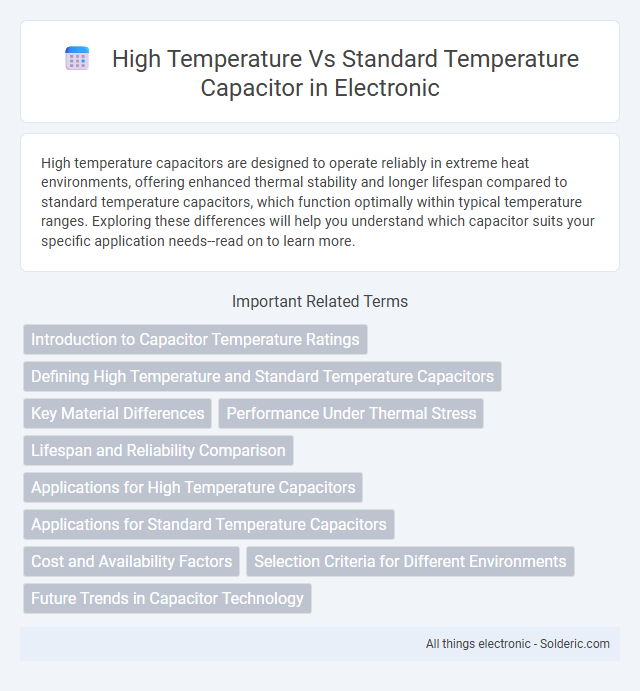High temperature capacitors are designed to operate reliably in extreme heat environments, offering enhanced thermal stability and longer lifespan compared to standard temperature capacitors, which function optimally within typical temperature ranges. Exploring these differences will help you understand which capacitor suits your specific application needs--read on to learn more.
Comparison Table
| Feature | High Temperature Capacitor | Standard Temperature Capacitor |
|---|---|---|
| Operating Temperature Range | Up to 150degC or higher | Typically up to 85degC to 105degC |
| Material | Specialized materials (e.g., ceramic, tantalum with high-temp ratings) | Common materials (e.g., aluminum electrolytic, standard ceramic) |
| Lifespan at High Temp | Extended lifespan under high heat conditions | Reduced lifespan when exposed above rated temps |
| Cost | Higher cost due to materials and design | Lower cost, mass-produced |
| Applications | Automotive, aerospace, industrial electronics | Consumer electronics, general-purpose circuits |
| Size | Often larger due to additional thermal management | Typically smaller |
| Voltage Rating | Similar or higher for robustness | Standard voltage ratings |
Introduction to Capacitor Temperature Ratings
High temperature capacitors are designed to operate reliably at elevated temperatures, typically up to 125degC or 150degC, compared to standard temperature capacitors which usually function within a range up to 85degC. The temperature rating directly impacts the capacitor's lifespan, electrical stability, and performance under thermal stress. Selecting the appropriate temperature rating ensures optimal durability and efficiency in applications such as automotive, industrial, and power electronics where thermal conditions vary significantly.
Defining High Temperature and Standard Temperature Capacitors
High temperature capacitors are designed to operate reliably at temperatures typically above 125degC, with some models rated up to 200degC, making them suitable for extreme environments such as automotive, aerospace, and industrial applications. Standard temperature capacitors generally function within the range of -55degC to 85degC, serving common electronic devices with less thermal stress. Material composition, dielectric types, and sealing methods distinguish high temperature capacitors from standard ones, ensuring enhanced durability and performance under elevated thermal conditions.
Key Material Differences
High temperature capacitors utilize dielectric materials such as ceramic types like C0G/NP0 or specialized polymers that maintain stability at temperatures up to 150degC or higher, unlike standard temperature capacitors which typically use materials rated for 85degC to 105degC. Electrolytes in high temperature capacitors are formulated with higher thermal tolerance to prevent breakdown and extend lifespan under extreme heat conditions. The electrode metallization and encapsulation materials in high temperature capacitors also feature enhanced thermal stability to ensure reliable performance in demanding environments.
Performance Under Thermal Stress
High temperature capacitors maintain stable capacitance and low equivalent series resistance (ESR) when exposed to elevated temperatures above 125degC, ensuring reliable performance in harsh environments. Standard temperature capacitors typically operate optimally up to 85degC, where they may experience significant degradation in capacitance and increased ESR under thermal stress. This thermal stability difference impacts longevity and functionality in applications such as automotive electronics, industrial machinery, and aerospace systems.
Lifespan and Reliability Comparison
High temperature capacitors typically offer shorter lifespans ranging from 1,000 to 5,000 hours at elevated temperatures around 125degC, compared to standard temperature capacitors which can last 2,000 to 10,000 hours at 85degC. Elevated operating temperatures accelerate electrolyte evaporation and dielectric degradation, reducing reliability in high temperature capacitors. Standard temperature capacitors demonstrate higher reliability in typical circuit conditions due to slower aging processes and lower thermal stress.
Applications for High Temperature Capacitors
High temperature capacitors are specifically designed to withstand elevated temperatures up to 200degC or more, making them ideal for applications in harsh environments such as automotive engine control units, aerospace electronics, and industrial equipment exposed to extreme heat. These capacitors offer enhanced reliability and stability under thermal stress compared to standard temperature capacitors, which typically operate up to 85degC or 105degC. Selecting the right high temperature capacitor ensures your electronic systems maintain performance and longevity in demanding thermal conditions.
Applications for Standard Temperature Capacitors
Standard temperature capacitors are widely used in consumer electronics, including smartphones, laptops, and audiovisual equipment, where operating conditions are within normal ambient temperature ranges of -40degC to 85degC. These capacitors provide reliable performance in applications such as power supplies, motor drives, and signal processing circuits that do not require extreme thermal resilience. Their cost-effectiveness and availability make them ideal for mass-produced electronic devices that operate under typical environmental conditions.
Cost and Availability Factors
High temperature capacitors typically cost more than standard temperature capacitors due to specialized materials and manufacturing processes designed to withstand elevated temperatures. Availability of high temperature capacitors can be limited compared to standard versions, as they cater to niche applications in industries like aerospace or automotive. Your choice between the two should consider both budget constraints and the operational temperature requirements to ensure optimal performance and cost-efficiency.
Selection Criteria for Different Environments
High temperature capacitors are designed to withstand extreme heat, making them ideal for environments exceeding 125degC, while standard temperature capacitors function effectively at typical ranges up to 85degC. Your selection should consider operational temperature, thermal stability, and the application's exposure to heat cycling to ensure reliability and longevity. Materials like ceramic or tantalum in high temperature capacitors provide enhanced performance under thermal stress compared to traditional electrolytic types used in standard conditions.
Future Trends in Capacitor Technology
High-temperature capacitors are evolving to meet stringent demands in aerospace and automotive industries, offering enhanced thermal stability and extended lifespan compared to standard temperature capacitors. Future trends emphasize the integration of advanced materials like ceramics with high dielectric constants and polymer composites to improve capacitance and reliability under extreme conditions. Your choice of capacitor will benefit from innovations in nanotechnology and smart sensors that enable real-time monitoring and predictive maintenance in critical applications.
high temperature vs standard temperature capacitor Infographic

 solderic.com
solderic.com